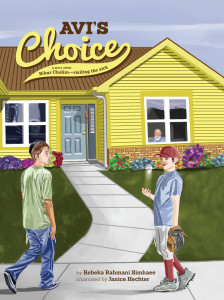Avi’s Choice is a picture book about Bikur Cholim, visiting the sick. Avi has a big baseball game and his friends are waiting. But his grandpa is sick and a visit from Avi would really cheer him up! Avi’s Choice is written by Rebeka Rahmani Simhaee and illustrated by Janice Hechter. Janice is a multi-talented artist and author. I was so pleased to chat with her about the creative process of illustrating a picture book. I enjoyed learning about an illustrator’s perspective.
How were you selected to illustrate Avi’s Choice?
I had e-mailed the editor at Merkos my online portfolio and he liked my illustrations. He felt that my style of work would be perfect for Avi’s Choice.
What challenges did you face illustrating the story?
The entirety of Avi’s Choice takes place in one location – Avi’s house. It also highlights three people in much of the story. In order to make things more interesting I looked for opportunities in which I could vary both the setting and characters. One example is when Avi discusses his upcoming baseball game with his father. Even though their conversation takes place inside their home, I chose to depict what the conversation was about by illustrating Avi and his friends outside, playing a game of baseball. This allowed me to not only change the locale, but also to feature the action of a baseball game, which is something young readers can easily identify with and enjoy. Viewers also get a peek at some of Avi’s friends. Another example is in a scene in which Avi confers with his mother. Again, this scene takes place inside their home, so I decided to portray what they are talking about, which is Avi’s hypothetical visit with his grandfather. This gives the viewer an opportunity to meet and actually see Grandpa, as well as offer a glimpse into Avi’s relationship with his grandfather. For the cover of Avi’s Choice, I needed to create intrigue, while not giving away the outcome. I decided to use the opportunity to show the outside of Grandpa’s house, a backdrop which is only seen in this one instance. All of the elements of Avi’s dilemma are encompassed right on the cover of the book.
Can you tell me about your process and some techniques that you use to create art for children’s books?
First, I go through the manuscript and decide which scenes to illustrate and what will be happening in each illustration. I then write up a description of each potential illustration and whether it will be a spread (two pages wide) or a single page and e-mail it to the publisher. After a committee reviews my ideas, I am then sent an e-mail which contains their thoughts and opinions. When the publisher approves of my ideas, I then proceed to look for models to pose for me. Then it’s time to create black and white sketches. I draw my sketches using my pen and WACOM tablet. I have to be sure to allow room for the text to appear. I also have to be sure that important elements in the illustration do not end up on or too near the gutter, which is the crease down the center of the spread. The publisher reviews the sketches and this is the time when a lot of the changes are requested by the publisher. Elements are moved around, eliminated, made both smaller and bigger. Mezuzahs are rotated, beards made longer, changes in attire, and facial expressions revised.
This is where I am thankful to be able to make all these changes on my tablet. It is a lot easier to change one piece of a sketch on my computer than have to toss out a completed drawing and start anew every time a revision is requested. Once all sketches are approved by the publisher I begin to draw in color. I have a large monitor and paint in a program called Corel Painter, which simulates traditional artists’ materials and tools. My favorite tool is the old worn pastel. I also enjoy using the airbrush and blender brushes. I use a variety of paper textures and mix my own colors. I am able to paint with whichever brush size I want. More or less of the paper texture shows up depending on which media I am using and how hard I press my pen on the tablet. I can easily erase and do not have to wait for paint to dry. I especially like creating my own fabrics for the clothes the people are wearing. The thing I like most about working digitally is that I am able to try as many variations of a painting as I like without fear of losing my original art work. This makes me a lot more creative and apt to experiment with new methods. Once all the illustrations are complete, I go over my finished illustrations and the manuscript once again and think of ideas for the cover. Multiple sketches are made, reviewed, and revised until the publisher is satisfied.
You also have a new book coming out called Wish Upon a Starfish. How do the creative processes differ between writing and illustrating?
I am always thinking up new stories to tell by reading news stories or hearing about real life events from my family, as well as situations I have personally experienced. To me, the creative processes between writing and illustrating are very similar. I feel like I am painting with words when I write. I experience the same burst of creative energy in both media and the same sense of accomplishment when everything comes together. In both illustrating and writing my work is reviewed and commented on and many revisions are made. I am a member of two writing critique groups but I do not belong to an illustration critique group, so I do not get as much outside feedback on my illustration as I do with my writing. I do like the sense of community that critique groups afford. I have been illustrating picture books a lot longer than I’ve been writing them, so the writing is a newer form of expression for me. One thing that differs with writing and illustrating is that I can come up with words for my stories while involved in other activities, such as bicycling, walking, gardening, or riding in a car. I cannot do these activities while illustrating, as a steady hand is necessary. Conversely, I can listen to music while illustrating, but need quiet when writing.
Janice – Thanks for sharing your insights!
To learn more about Janice and her work, please visit her website at www.janicehechter.com


Wonderful work, Janice! I hope to see a lot more of it in the coming year. Mazel Tov!.